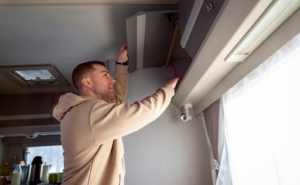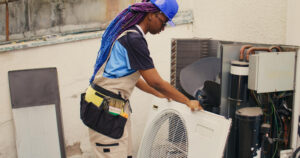Menu

Safeguarding School Environments: The Importance of Air Quality
The air quality in educational facilities plays a critical role in the health and well-being of both students and staff. In recent years, attention has been focused on the importance of indoor air quality (IAQ) in schools. Studies have shown that poor air quality can have a direct impact on cognitive function, academic performance, and overall well-being.
As a result, schools and educational facilities need to prioritize proper air quality management. Poor air quality can arise from various challenges, including poor ventilation, inadequate HVAC maintenance, and the presence of various indoor pollutants.
Educational facilities often host large numbers of students and staff, contributing to increased generation of carbon dioxide (CO2) and other airborne contaminants. Moreover, activities such as science experiments, art projects, and the use of cleaning supplies may introduce fumes and pollutants. These factors make robust HVAC systems and maintenance imperative for maintaining a healthy learning environment.
With that in mind, let’s explore the essential elements of indoor air quality in schools and educational facilities, discuss the consequences of inadequate IAQ, and identify key solutions for maintaining optimal air quality. By understanding the importance of a well-maintained HVAC system and its impact on a learning environment, facility managers can work with professional HVAC companies like Bromac Mechanical to ensure a healthy and productive atmosphere for students and staff.
Understanding Key Indoor Air Quality Components
Maintaining good indoor air quality (IAQ) in educational facilities hinges on several interrelated elements. Some of these essential components include:
1. Air filtration: Effective air filters are crucial for capturing and removing airborne contaminants such as dust, pollen, and other particulates. These filters should be checked and replaced regularly to ensure optimal function.
2. Ventilation: Proper ventilation ensures a continuous supply of fresh outdoor air and contributes to reducing indoor air contaminants. Adequate fresh air intake and distribution help maintain a healthy and comfortable indoor environment.
3. Humidity control: Maintaining an appropriate indoor humidity level (between 30% and 50%) helps discourage the growth of mould and mildew. Proper humidity control also contributes to a comfortable learning environment and mitigates respiratory issues.
4. Source control: Effective source control strategies focus on minimizing the introduction of pollutants from activities, materials, and equipment typically used in educational facilities.
The Consequences of Inadequate Indoor Air Quality
Poor air quality can lead to a wide range of health problems and detrimental effects on academic performance. Some of the consequences of poor IAQ in schools and educational facilities include:
1. Increased Respiratory Issues: Students and staff exposed to poor IAQ may experience exacerbated asthma symptoms, allergies, and other respiratory issues.
2. Adverse Cognitive Effects: Studies have shown that poor indoor air quality can negatively impact cognitive abilities, including memory, attention, and decision-making.
3. Increased Absenteeism: The presence of pollutants, allergens, and poor ventilation can contribute to an increased number of student and staff absences due to health-related issues.
4. Lowered Academic Performance: The combination of health effects and reduced cognitive function can lead to decreased classroom performance.
Key Solutions for Maintaining Optimal Air Quality
Improving air quality in educational facilities can have a significant impact on the well-being and academic performance of students and staff. Here are some essential solutions for maintaining optimal IAQ:
1. Regular HVAC Maintenance
A well-maintained HVAC system is crucial for maintaining proper air quality in an educational facility. Facility managers should work with trusted HVAC professionals like Bromac Mechanical to conduct regular inspections, filter replacements, and system tune-ups. This practice ensures efficient HVAC operation while addressing any potential air quality issues early on.
2. Proper Ventilation and Exhaust Systems
A well-ventilated environment is essential for promoting good IAQ. Facility managers should ensure that their ventilation systems are providing sufficient fresh air and evenly distributing it throughout the building. Additionally, proper exhaust systems should be in place to eliminate pollutants generated during specific activities such as science experiments or art projects.
3. Effective Humidity Control
Proper humidity control is crucial for preventing the growth of mould and mildew in educational facilities. Facility managers should aim to maintain an indoor relative humidity level between 30% and 50% and collaborate with HVAC professionals to ensure optimal system performance.
4. Implementing Source Control Strategies
Strategies for controlling the introduction and spread of pollutants should be developed and implemented. Examples of effective source control strategies include using low-emission building materials and cleaning supplies, limiting the use of harsh chemicals, and promoting good housekeeping practices.
Collaborating with HVAC Professionals for a Healthy Learning Environment
Success in maintaining optimal air quality in an educational facility often depends on partnering with trusted HVAC professionals like Bromac Mechanical. By working with experienced industry experts, facility managers can benefit from their valuable knowledge and experience. Some advantages of partnering with HVAC professionals include the following:
1. Customized Solutions: HVAC professionals understand that each educational facility has unique needs and challenges. They will assess the situation and develop tailored HVAC and IAQ solutions to cater to specific requirements.
2. Ongoing Maintenance and Support: Regular maintenance and support from knowledgeable professionals can extend the life and efficiency of your HVAC system, lower operational costs, and maximize indoor air quality.
3. Indoor Air Quality Monitoring: HVAC experts can assist in setting up monitoring systems to measure key IAQ indicators such as CO2 levels, temperature, and humidity, ensuring a healthy and comfortable learning environment.
4. Expert Advice and Recommendations: HVAC professionals provide valuable guidance on best practices for maintaining good indoor air quality and can recommend effective source control strategies specific to your educational facility.
The Role of Clean Air in Boosting Learning in Educational Facilities
Recognizing the vital role that indoor air quality plays in educational settings is key to fostering a safe, healthy, and productive learning environment. By partnering with experienced HVAC professionals like Bromac Mechanical, educational facility managers in Abbotsford can confidently address IAQ challenges and provide a comfortable and positive atmosphere for students and staff alike.
With a keen understanding of the importance of air quality and the complexities of HVAC systems and maintenance, Bromac Mechanical’s team of licensed plumbers is ready and equipped to guide your educational facility toward optimization. Your students and staff will benefit from the improvements made, ultimately contributing to enhanced academic performance and overall well-being.


